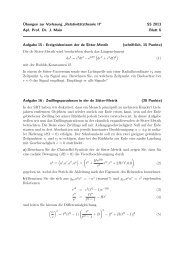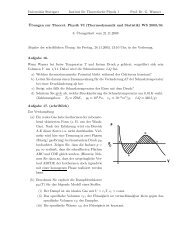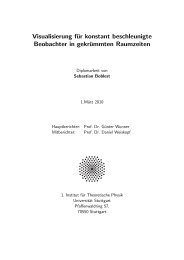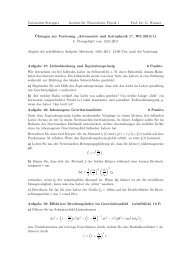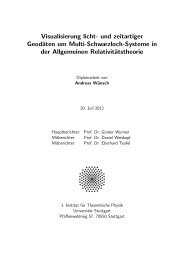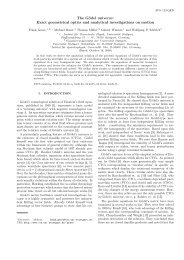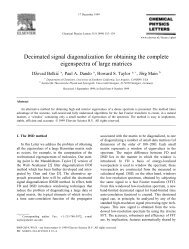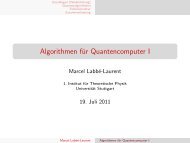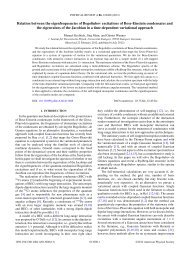2.6M - 1. Institut für Theoretische Physik - Universität Stuttgart
2.6M - 1. Institut für Theoretische Physik - Universität Stuttgart
2.6M - 1. Institut für Theoretische Physik - Universität Stuttgart
Sie wollen auch ein ePaper? Erhöhen Sie die Reichweite Ihrer Titel.
YUMPU macht aus Druck-PDFs automatisch weboptimierte ePaper, die Google liebt.
machines for an equal load. Because of branching the number of walkers varies. The<br />
example output of the program is described and given in listing 4.3. The chapter ends<br />
with some special hints as to the capacity of the used cluster of the HLRS (appendix E).<br />
Comparison with other Methods: The results of the Variational and Diffusion Quantum<br />
Monte Carlo simulation are compared by means of tables and diagrams. The ground<br />
state energy E0 was determined for a constant external magnetic field, and decreases with<br />
nuclear charge number Z . There is a correlation between tables and diagrams which are<br />
arranged in order of the magnetic field strength B:<br />
� B = 10 7 T: Table 5.1 (page 68), figures 5.1 up to 5.9 (page 71 up to 75)<br />
� B = 5 · 10 7 T: Table 5.2 (page 68), figures 5.10 up to 5.22 (page 75 up to 81)<br />
� B = 10 8 T: Table 5.3 (page 69), figures 5.23 up to 5.47 (page 82 up to 94)<br />
� B = 5 · 10 8 T: Table 5.4 (page 70), figures 5.48 up to 5.72 (page 94 up to 106)<br />
For clarity, the last column of each table contains the appropriate figure number. Both<br />
tables and diagrams include values of other methods for a direct comparison:<br />
� Hartree-Fock in adiabatic approximation with Finite Elements Method and Bspline<br />
interpolation (HFFEM [14])<br />
� 2 Dimensional Hartree-Fock (2DHF [8])<br />
� Multi Configurational Perturbative Hybrid Hartree Hartree-Fock (MCPH 3 [21])<br />
� Density Functional calculations (DF [11]).<br />
The figures 5.1 up to 5.72 show the evolution of the trial energy ET, the block energy<br />
EB and the average of the block energy 〈EB〉 plotted as a function of the number of the<br />
block. The variable block is counted from 1 to 700 only for these figures, although each<br />
part simulation starts internally with b = 1 and ends with b = bmax. The figures are<br />
therefore partitioned in three areas marked by a vertical solid line. This line represents<br />
the last block of the previous simulation. Each of these three areas is further separated<br />
in two parts marked by a vertical dashed line dividing the part which does not count<br />
to statistics (b = bs − 1) but is retained for achieving the dynamic equilibration. The<br />
first 100 blocks refer to Variational Quantum Monte Carlo simulation (VQMC), the<br />
blocks 101 up to 400 refer to fixed-phase Diffusion Quantum Monte Carlo simulation<br />
(FPDQMC) and the blocks 401 up to 700 refer to released-phase Diffusion Quantum<br />
Monte Carlo simulation (RPDQMC). Each block contains 200 steps. The HFFEM<br />
calculations not only provide the ground state energy but also the adiabatic guiding<br />
wavefunction Ψad G , which is afterwards multiplied by the Jastrow factor to obtain the<br />
input guiding wavefunction of the DQMC simulation. The free parameter bJF of the<br />
131




